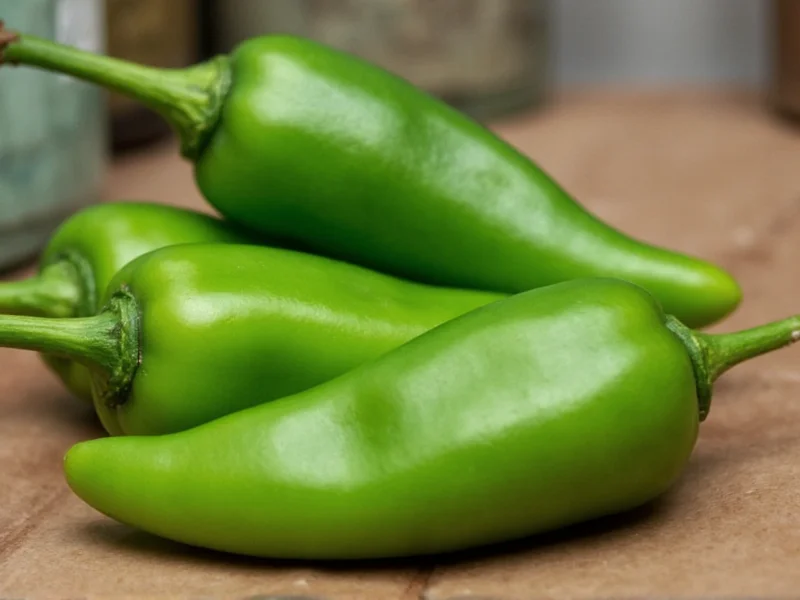Understanding the heat difference between these popular chili peppers is essential for home cooks and culinary professionals alike. This comprehensive comparison examines the scientific measurements, flavor profiles, and practical applications of both peppers to help you make informed decisions in your cooking.
Scoville Scale: Measuring Pepper Heat
The Scoville scale, developed by pharmacist Wilbur Scoville in 1912, measures the concentration of capsaicinoids—the compounds responsible for a pepper's heat. While modern high-performance liquid chromatography provides more precise measurements, the Scoville Heat Unit (SHU) remains the standard reference for comparing pepper heat levels.
| Pepper Variety | Scoville Heat Units (SHU) | Relative Heat Compared to Jalapeño |
|---|---|---|
| Jalapeño | 2,500-8,000 SHU | 1x (baseline) |
| Serrano | 10,000-23,000 SHU | 2-9x hotter |
| Habanero | 100,000-350,000 SHU | 12-40x hotter than serrano |
Physical Characteristics and Flavor Profiles
While heat measurement provides objective data, understanding the physical differences helps identify these peppers in the grocery store and informs their culinary applications.
Jalapeño Features
- Size: 2-3.5 inches long, 1-1.5 inches in diameter
- Shape: Smooth, tapered with rounded ends
- Color: Typically harvested green, but ripens to red
- Flavor: Grassier, more vegetal notes with moderate heat
- Common uses: Salsas, nachos, poppers, pickled jalapeños
Serrano Features
- Size: 1-4 inches long, noticeably thinner than jalapeños
- Shape: Pointed, often with wrinkled skin
- Color: Available in green, red, orange, and yellow varieties
- Flavor: Brighter, more floral notes with intense heat
- Common uses: Pico de gallo, hot sauces, guacamole, Mexican street corn
Practical Implications for Cooking
Knowing how much hotter is serrano than jalapeno directly impacts recipe execution. When substituting one for the other, consider these guidelines:
Substitution Ratios
When replacing jalapeños with serranos in recipes, use approximately one-third the amount of serranos to achieve similar heat levels. For example:
- 1 jalapeño = ⅓ serrano pepper (for equivalent heat)
- 2 jalapeños = ⅔ serrano pepper
- 3 jalapeños = 1 serrano pepper
Culinary Considerations
The serrano vs jalapeno Scoville scale difference affects more than just heat intensity:
- Texture: Serranos have thinner walls, making them better for raw applications
- Flavor complexity: Serranos offer brighter, more nuanced flavors that can enhance dishes beyond just heat
- Cooking time: Serranos lose heat more quickly when cooked compared to jalapeños
- Seeding impact: Removing seeds and membranes reduces heat more dramatically in serranos due to their higher capsaicin concentration
Safety Tips for Handling Hot Peppers
Working with serrano pepper heat level compared to jalapeno requires proper precautions:
- Always wear gloves when handling serranos, especially when seeding
- Avoid touching your face, particularly eyes, during preparation
- Wash cutting boards and knives thoroughly with soapy water after use
- If you experience burning, use dairy products (milk, yogurt) rather than water to neutralize capsaicin
- Start with smaller amounts of serrano when experimenting with recipes
Regional Variations and Growing Conditions
The actual heat level of both peppers can vary significantly based on growing conditions:
- Soil composition: Peppers grown in mineral-rich soil tend to be hotter
- Water stress: Moderate drought conditions increase capsaicin production
- Climate: Warmer temperatures generally produce hotter peppers
- Harvest time: Fully ripe (red) peppers are typically hotter than green varieties
This explains why you might occasionally encounter a particularly mild serrano or an unusually hot jalapeño, though the which is hotter serrano or jalapeno general rule remains consistent.
Popular Culinary Applications
Understanding the can I substitute serrano for jalapeno question requires knowledge of their best uses:
Jalapeño Best Uses
- Stuffed as jalapeño poppers (the thicker walls hold fillings better)
- Infused in oils and vinegars
- Chipotle peppers (smoked jalapeños)
- Commercial salsas where consistent, moderate heat is desired
Serrano Best Uses
- Fresh salsas where bright heat is preferred
- Hot sauces requiring clean, intense heat
- Garnishes where visual appeal matters (multiple color varieties)
- Dishes where you want heat without overwhelming vegetable flavor











 浙公网安备
33010002000092号
浙公网安备
33010002000092号 浙B2-20120091-4
浙B2-20120091-4